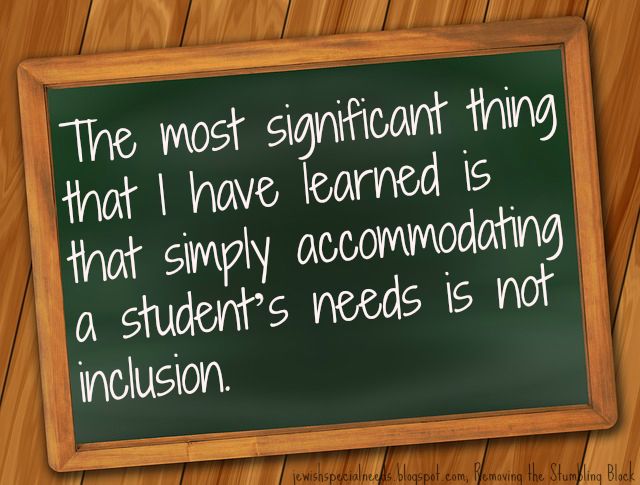Working with students of different abilities to ensure they have access to a meaningful Jewish education enables me to revisit my own personal commitment to inclusion over and over again. Over the years I have learned amazing strategies and techniques in adapting curriculum, shaping lessons, and accommodating individual students' needs.
However, the most significant thing I have learned is that simply accommodating
a student’s needs is not inclusion. Don’t get me wrong, making appropriate accommodations is an essential strategy
in working with all students who have unique learning needs. But there’s more to inclusion.
Let me give you an example:
A class of students is going to break into chevruta
(partner groups) to study a Jewish text. A written copy of the text is given to each student. The teacher decides that since this is a
discussion-based activity, the text can be read aloud to a student who is
blind and she can still fully participate.
What’s wrong with this?
Put yourself in the scenario. Are you typically the one who says (when
something is read aloud), “Let me see that, I missed half of what you
said.”? If so, you are probably a visual
learner. (Read more about learning styles.) This is how Braille can function for a
student that is blind; it’s her way of “seeing” the text for herself.
Students will be working in groups to explore leadership and
community building. The activity relies on students' ability to observe one another as they engage
in the task. Adding a listening role
to the group for a student who is blind is a reasonable accommodation, but
adding that same role to every group is inclusive.
One more:
Making sure there is a chair available for a student who has a physical disability is a reasonable accommodation, but reshaping the activity so that all of the students will sit is inclusive.
One more:
Making sure there is a chair available for a student who has a physical disability is a reasonable accommodation, but reshaping the activity so that all of the students will sit is inclusive.
Inclusion isn't always easy. Sometimes it takes trial and error. And it takes both intentionality and planning.
As we learn from Rabbi Tarfon in Pirkei Avot: "It is not your responsibility to finish the work [of perfecting the world], but neither are you free to desist from it." (2:16)
Be sure you never miss a post from Removing the Stumbling Block:
As we learn from Rabbi Tarfon in Pirkei Avot: "It is not your responsibility to finish the work [of perfecting the world], but neither are you free to desist from it." (2:16)


Many blind/visually impaired students today do not know Braille and access print using technology such as screen reader software, large print, software that enlarges text, such as Zoomtext. It is often enough to have an electronic version ready, or available in advance for the student to use in their own type of technology. The teacher can't assume to know what is best for a student with a disability. It's best to talk with the student and find out their preference, and not presuming to know what will work for a student. This helps the student to learn to advocate for his or her own needs, and shows the other students that it is important to respect the student's different ways of accessing material.
ReplyDeleteGreat points, Paula. I couldn't agree more! Thanks for sharing.
ReplyDelete